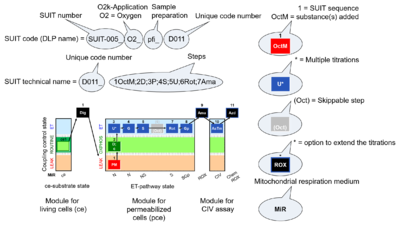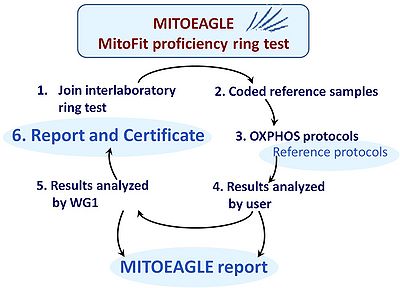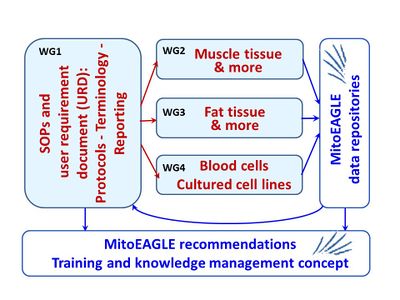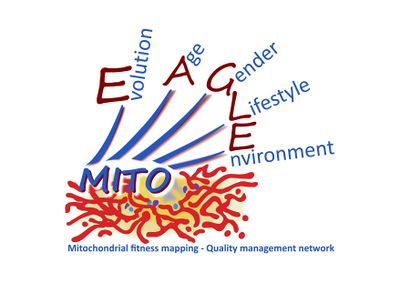MitoFit SC 2016 Programme information
From Bioblast
A1: Diagnostic SUIT protocols of mitochondrial fitness
- MitoPedia: SUIT
- A ‘library of SUIT protocols’ applied in mitochondrial respiratory physiology is collected in a standard format, delineating the diversity of experimental approaches to assess bioenergetic function. A set of reference protocols and validated standard protocols will rigorously document (Maelstrom Research program) the state-of-the-art in designing, conducting, reporting, interpreting, and validating such bioenergetic tests.
- MitoPedia: SUIT
|
- Further details: MitoEAGLE protocols, terminology, documentation
A2: Quality management system for mitochondrial respirometry: the MitoFit proficiency test
- Quality management system (QMS)
- The quality of any database is not better than the quality of the primary constituent datasets. Rigorous standards have to be applied to forge information into knowledge. Comparability of data generated by different labs on OXPHOS performance is restricted due to different laboratory protocols applied. Harmonization is clearly required along these lines, including the establishment of mitochondrial reference samples for inter-laboratory proficiency tests, and guidelines for data analysis and reporting (http://www.equator-network.org/).
- Quality management system (QMS)
- There is no QMS commonly available in the field of mitochondrial respirometry and bioenergetics. Without networking on a large scale it is not possible to implement a widely or even generally accepted set of standards that is required for harmonization of datasets.
- Interlaboratory proficiency test
- Inter-laboratory ring tests are a basic requirement for quality management. Such proficiency tests require a reference sample which must be homogenous, stable, representative of the diagnostic target, amenable for distribution, and economical for large-scale production. For respiratory OXPHOS analysis a reference sample of structurally and functionally intact mitochondria is not yet available to perform corresponding ring tests (in contrast to enzymatic OXPHOS ring tests). Recently, the widely applied human cell line HEK 293T was found to be potentially suitable for cryopreservation. Upon thawing the cells can be used immediately for respirometry of both intact and permeabilized cells. Thus interlaboratory proficiency testing may now be feasible as a world-wide innovation in the field of mitochondrial respiratory physiology. Participating labs may implement the test for intra- and interlaboratory validation and longitudinal performance monitoring, using a SUIT reference protocol. Feedback from the participants will lead to adjustments of the SOPs in the proficiency test, which will be made generally available.
- Comparison of results between and within instrumental platforms: The reference protocols and proficiency test will not define the instrumental platform, but will allow a quantitative comparison of results obtained with specific equipment available in the participating laboratories.
- From standardization to harmonization: MitoPedia
- The logistics of development of a database requires application of strictly defined terms for all included variables. There is no general reference available upon which a consistent terminology on mitochondrial physiology and bioenergetics can be based. The MitoEAGLE consortium, therefore, has to accomplish the ambitious goal to unify and simplify the terminology in the field for the purpose of the QMS, which will lead to the development of recommendations for the use of a common terminology in mitochondrial physiological research. A publication will be prepared as an Open Access article which will be a milestone towards a unification of concepts and nomenclature.
- MitoEAGLE will elaborate definitions of fundamental terms as required by the data management system, including a review on normalization of the data (tissue mass, cell protein, mt-markers such as mt-volume, mt-protein, mt-marker enzymes, flux ratios).
- From standardization to harmonization: MitoPedia
|
- Further details on WG1:
B1: Mitochondrial assays in blood cells
- Biopsy sampling of human muscle and fat tissue for mitochondrial studies is an invasive approach. More recently measurement of mitochondrial function in human blood cells – as well as temporary cryopreservation (Karabatsiakis 2014 Translational Psychiatry) – has become an attractive and by far less invasive alternative for mitochondrial diagnostics. Mitochondrial function of blood cells was linked with numerous diseases and metabolic conditions such as sepsis, neurodegenerative diseases, depression, hypertension, amyotrophic lateral sclerosis, and early-stage heart failure (e.g. Sjoevall 2013 Crit Care; Karabatsiakis 2014 Translational Psychiatry; Hagl 2014 J Alzheimers Dis). The use of human blood cells will thus predictably widen the applicability of respirometry in human physiology and will provide a significant stimulus for the entire field of mitochondrial medicine.
- A key towards achieving comparability among data sets and the applicability of human blood cells for the evaluation of mitochondrial fitness in health and disease is the standardization of the procedures to separate or isolate blood cells, the experimental procedure for the evaluation of mitochondrial respiratory characteristics, and the format for reporting.
- Following the MitoFit Workshop Blood Cells 2016-01-08, this will be the 2nd Workshop on blood cell respirometry for mitochondrial research and diagnostic applications.
|
- Further details on WG4: MitoEAGLE data: blood and cultured cells
B2: Cell culture models versus tissue samples: - Brain and neuronal cells - Adipose tissue - Other
- Mitochondrial function in fat tissue has received increasing attention. Adipose tissue exerts not only important endocrine but also metabolic functions. Several studies have investigated mt-capacities in this context, showing that changes in the expression of body fat and adipocytes can be traced to alterations of mt-functional characteristics (Yin 2014 J Clin Endocrinol Metab). In morbidly obese patients adipocytes from visceral vs subcutaneous fat depots show distinct respiratory control patterns (Kraunsoee 2010 J Physiol), a finding later confirmed in mice. The great potential of respirometric investigations of fat tissue can be further exploited by developing interlaboratory diagnostic standards.
|
- Further details on WG3: MitoEAGLE data: fat
B3: Mitochondrial studies in neurodegeneration
|
C1: Skeletal and cardiac muscle fibres - towards a data repository.
- During the past 10 years, a dramatically increasing number of studies report respirometric data on human muscle tissue (O2k-Publications: Skeletal muscle. However, despite the many published data, lack of consistency often precludes quantitative comparison among data sets with permeabilized or homogenized muscle fibres or isolated mitochondria, normalized to either tissue wet weight, dry weight, protein content, citrate synthase activity or other mitochondrial markers. In the absence of validated conversion factors, these data remain largely unconnected and can only be qualitatively linked.
- The aim will be to provide access to complete data sets for post-study statistical analysis and use harmonization tools for standardized documentation, to initiate a data repository on muscle tissue from humans and model organisms in health and disease. Data sets shall be obtained from already published and new studies, prompting participating labs to report experimental details beyond those already published as far as possible (using tools such as PubMed Commons). Specific protocols are presented and compared for handling muscle tissue.
|
- Further details
D1: Towards a database on mt-respiratory physiology: from laboratory standards to inter-laboratory harmonization
- Adherence to common standards is likely to increase the proportion of true findings (Ioannidis 2005; Fortier et al 2010). A data bank with harmonized datasets will advance significantly the field of human and comparative bioenergetics research and provide the level of knowledge required for helping health systems to evolve.
- The complexity of evolutionary background, age, gender, lifestyle and environment (EAGLE) linked to mitochondrial function cannot be addressed in the conventional small-scale studies with 20 subjects (rather than 2,000 or 200,000). To come anywhere near to large sample sizes, pooling of information between studies is essential on a global scale.
- Scientists may refute the challenge of comparing, optimizing and even pre-registering their protocols, when employment and assessment procedures exert stronger pressures on unhealthy competition by high-profile publication than on time-consuming quality control by collaboration. Young investigators may lack a broad perspective on methodological standards and may be reluctant to deviate from a trotten path. MitoEAGLE, however, will bring a large group of mitochondrial experts together by demonstrating the added value for each individual project, when harmonization of protocols will allow scattered data to be combined as the only means to overcome severe limitations of the traditional scientific approach (Fortier 2010 Int J Epidemiol).
- Rigorous standardization is the gold standard for data pooling, but may not be achievable at the present level of research in mt-physiology, where different preparation protocols, incubation media and respiratory protocols are used. Therefore, unrealistic efforts towards developing and implementing a defined standard will be replaced by a translation strategy: Major subprotocols (e.g. different respiration media) will be compared (facilitated by STSM and workshops) to allow quantitative conversion of results obtained by different groups following their specific ‘standard’ operating procedures. This will be a first evolutionary step towards harmonization and standardization.
- An ‘absolute‘ gold standard may remain inherently unattainable, as is the case in most fields of contemporary bioscience. Practically, the least common denominator that can be agreed upon may remain disappointingly fragmented, particularly in a large and diverse consortium involving stakeholders represented by university-based and industry-based scientists. Senior stakeholders may be biased by a commitment to their established - scientifically published or commercially sold - procedural protocols, which appear to be ‘accepted’ (by peer review) or ‘accredited’ (by revenues).
- » Compare: Mitochondrial disease sequence data resource - https://mseqdr.org/
|
- Harmonization of nomenclature on mitochondrial respiratory states and control parameters: The logistics of development of a database requires application of strictly defined terms for all included variables. There is no general reference available upon which a consistent terminology on mitochondrial physiology and bioenergetics can be based. The MitoEAGLE consortium, therefore, has to accomplish the ambitious goal to unify and simplify the terminology in the field for the purpose of the QMS, which will lead to the development of recommendations for the use of a common terminology in mitochondrial physiological research. A publication will be prepared as an Open Access article which will be a milestone towards a unification of concepts and nomenclature.
D2: Mitochondrial health: molecules, cells and tissues
- Diseases that are strongly related to a sedentary life style are spreading world-wide at an epidemic scale. Mitochondrial dysfunction is increasingly associated with the progression of such pathologies: cause or consequence? There is currently no regimented, quantitative system, or database organised to routinely test, compare and monitor mitochondrial capacities within individuals, populations, or among populations. This reflects the need for scientific innovation and represents a shortcoming in the health system of our modern, rapidly ageing society. Traditional lifestyles of ‘remote’ human populations are dwindling such that these highly significant windows into our evolutionary past are about to becoming closed, forever. While studies of mitochondrial DNA (mtDNA) have become increasingly established in the search for the evolutionary history and diversification of the human species, mitochondrial function remains comparatively unexplored, but may turn out to provide key information for preventing diseases which become prevalent upon transition to a Westernized lifestyle. The presently observed acceleration of research on cell and mitochondrial respiration represents a challenge to transform scientific information into knowledge and translate complex results on mitochondrial (dys)function into a patient-related mitochondrial score. Diagnostic standards, however, are lacking. A concerted action of the scientific community is required to implement quality control systems and optimally harmonize protocols across research groups. The primary challenge is to ‘increase value and reduce waste in research design, conduct, and analysis’, to separate the signal from the noise (Ioannidis 2005 PLoS Med; The Lanzet 2014): ‘The signal is the truth. The noise is what distracts us from the truth’ (Silver N: The signal and the noise. The art and science of prediction. Penguin Press 2012).
|
D3: MoTrPAC and MitoEAGLE
- The molecular transducers of physical activity consortium (MoTrPAC) and MitoEAGLE: exercise effects on mitochondria
|
E1: MitoEAGLE and parallel IOC112 O2k-Workshop
|
E2: MitoEAGLE and parallel IOC112 O2k-Workshop
|
 * IOC112 - O2k-Workshop.
* IOC112 - O2k-Workshop.






